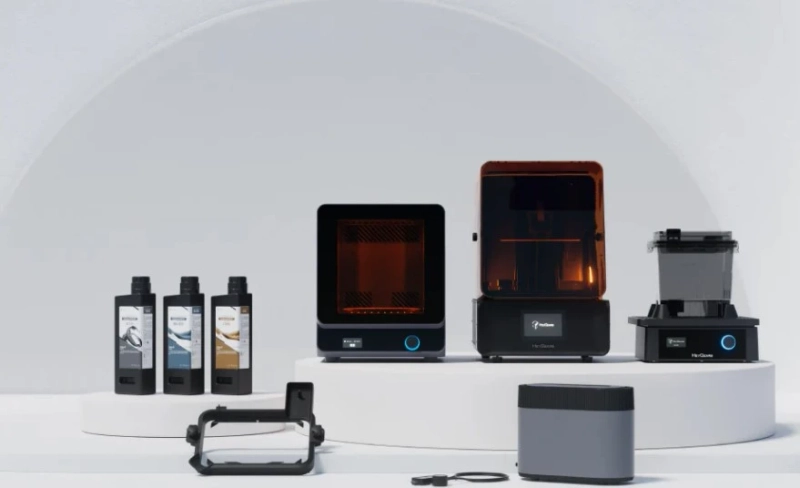Over the past few years, resin 3D printing has become an essential tool for hobbyists, designers, and professionals alike. Whether you're crafting tabletop miniatures with jaw-dropping detail or producing precise dental models, a good resin 3D printer can take your work to the next level. But with so many models on the market, finding the right one can feel overwhelming. If you're wondering which machine truly qualifies as the best resin 3D printer for your needs, this guide is here to simplify the decision-making process.
Why Resin 3D Printing?
Before we jump into comparisons, it’s worth understanding why resin printing is so popular—especially when compared to filament-based (FDM) printers.
Resin printers use stereolithography (SLA), digital light processing (DLP), or masked stereolithography (MSLA) to cure liquid resin layer by layer. This allows for significantly higher resolution and smoother surface finishes than FDM machines.
Here are some clear advantages:
- Exceptional detail and accuracy
- Ideal for small or complex parts
- Smooth surface finishes with minimal post-processing
- Widely used in industries like dentistry, jewelry, and product prototyping
Key Factors to Consider When Choosing a Resin 3D Printer
Choosing the best resin 3D printer means evaluating what really matters to you. Here’s a breakdown of the most critical factors:
1. Print Quality and Resolution
This is the heart of resin printing. High-resolution screens (like 4K or 8K LCDs) dramatically improve detail, especially on miniature or functional parts. Look for XY resolutions of 50 microns or below if you need precision.
2. Build Volume
How big do you need to print? Some desktop resin printers have compact build volumes, which are perfect for small models. Others, especially mid-range and professional units, offer generous space without sacrificing quality.
3. Speed and Efficiency
Print speed depends on the type of printer and its exposure system. MSLA printers tend to be faster and more efficient for most users. Also, features like parallel light sources or mono-LCD screens speed up printing while reducing wear and tear.
4. Reliability and Ease of Use
From resin vat leveling to touchscreen interfaces, user-friendliness matters. Look for printers with intuitive software, robust construction, and good customer support. Wi-Fi connectivity and onboard memory are great pluses too.
5. Ecosystem and Compatibility
Some machines work best with proprietary resins; others are open-source. Consider whether you want the freedom to use third-party materials or prefer a controlled system designed for optimized results.
Top Picks for the Best Resin 3D Printer in 2025
While there’s no one-size-fits-all, several models stand out for different use cases:
For Beginners: Elegoo Mars 4
- Affordable and reliable
- 9K mono LCD screen for crisp prints
- Compact footprint for desktops
- Easy-to-use ChituBox slicing software
Perfect for hobbyists dipping their toes into resin printing without breaking the bank.
For Professionals: HeyGears UltraCraft Line
If you’re serious about accuracy and scalability—especially for commercial use—the UltraCraft series by HeyGears is turning heads. Known for their precise prints and exceptional build quality, these machines offer:
- Industrial-grade reliability
- Consistent high-speed performance
- Advanced software integration
- Great for dental labs, medical device prototyping, and product design
Honestly, it’s no surprise many experts consider it among the best resin 3D printer options available today.
For Versatility: Anycubic Photon Mono M5s
- 12K resolution screen
- Large build volume
- Built-in leveling and smart sensors
- Excellent for users who print a wide variety of models
Post-Processing Tips to Get the Most from Your Printer
Even the best resin 3D printer can’t shine without proper finishing. Once your print is complete, follow these steps:
- Wash with isopropyl alcohol or water (depending on resin type)
- Cure the print under UV light for durability
- Carefully remove supports using flush cutters
- Sand and prime for a professional finish (optional)
A good curing station or wash-and-cure combo device makes this process smoother and safer.
Safety First: Don’t Skip These Essentials
Resin printing involves chemicals that can irritate skin or produce fumes. Always work in a ventilated area and wear gloves and a mask during handling. Many modern printers have enclosed designs or air filters, but safety protocols still matter.
Final Thoughts
Choosing the best resin 3D printer isn’t just about picking the most expensive or popular model. It’s about finding the right tool that fits your workflow, budget, and ambition. Whether you're a hobbyist printing D&D miniatures or a business producing medical-grade components, there's a resin printer that will make your process smoother and your results shine.
Do your homework, invest in a quality machine, and don’t skimp on safety. Resin printing has come a long way—and there’s never been a better time to dive in.


